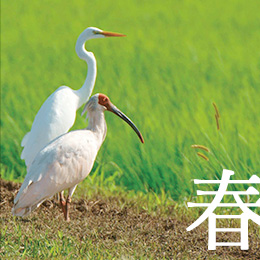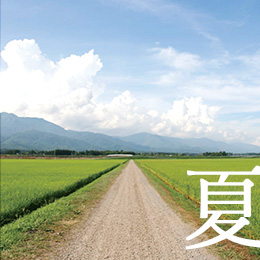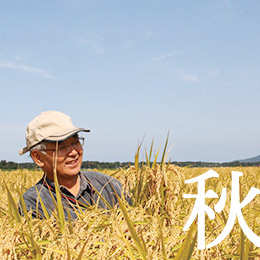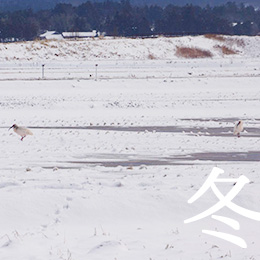米作りの1年
One year of rice growing春の作業
Spring of work耕起・種まきPlowing and sowing
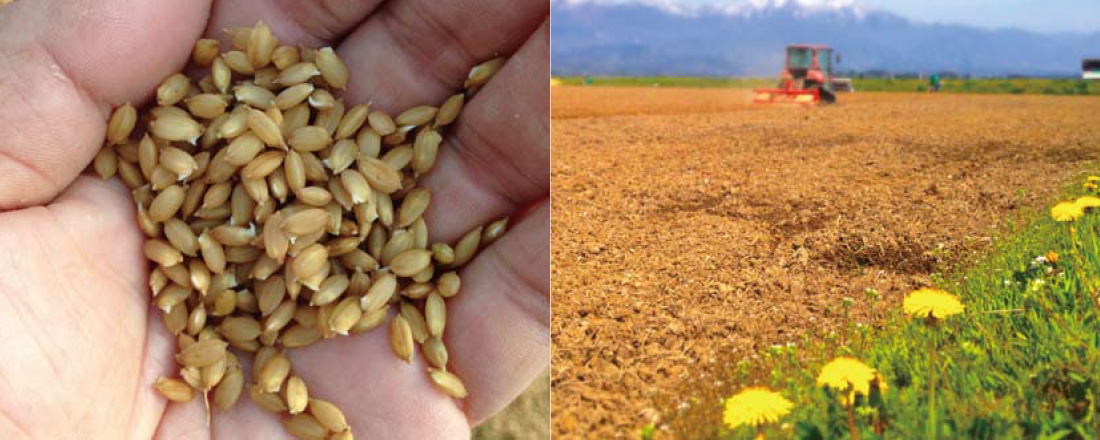
雪がとけ命芽吹く季節。田んぼの土を耕す「耕起」と「種まき」の作業がはじまります。田んぼ一面に広がっていた雪が溶け、春の陽射しがゆっくりと田を乾かします。
しっかりと田が乾くと最初の「耕起」に入ります。春の「耕起」は2回に分けて行います。まず荒打ちを行い土に春の空気を混ぜ込み、その後、団子状の細かい土の塊ができるよう打ち直します。
それが終わると栄養をたっぷり含んだ雪解け水を一斉に田んぼに張り、田植え前の「代かき」を待ちます。4月14日の地元の山王祭を境に本格的に「種まき」が始まります。2500箱以上の種まきは家族だけでなく地域の助っ人もお願いし4、5日間で行います。
Early spring is the season of plowing and sowing. Snow over the rice field melts and the spring sun dries the land.
After the land is dried, the plowing process starts. The plowing in spring has two stages: firstly mixing soil roughly with air, and then re-mixing to make finer clods. After the plowing, we fill the fields with well-nutritioned melted snow preparing for a process called puddling. On April 14 it starts to snow, and coincidently it aligns the Sannou Festival. About 2,500 boxes of seeds are sowed within 4-5 days by family members and also local village members.
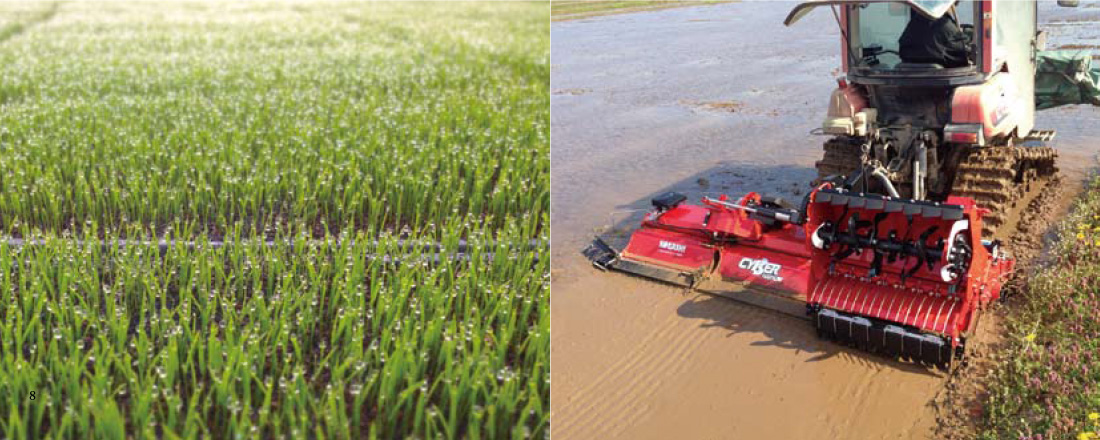
田植えPlanting
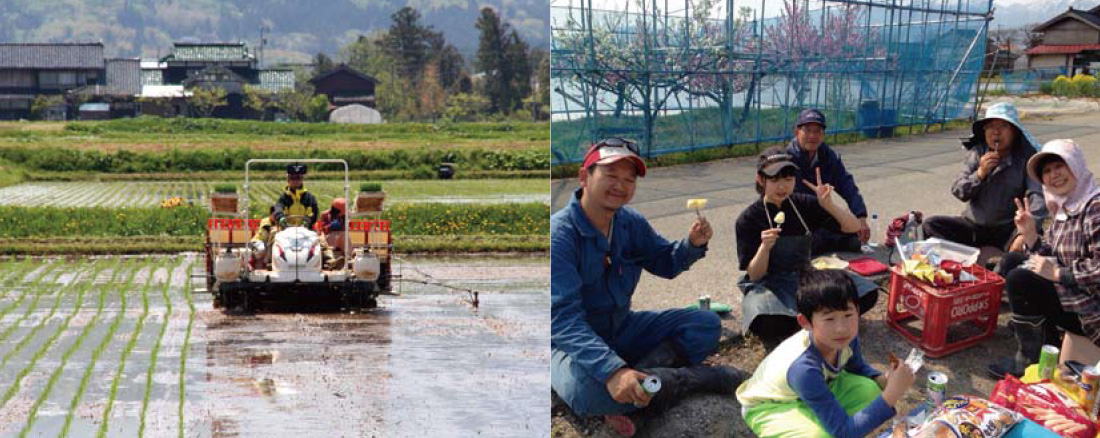
田植えの直前、4~5日前を目安に「代かき」を行います。水を張った状態にハローという機械でさらに細かく土を粒状に耕し、田んぼを水平にしていく作業です。
いよいよ5月中旬から田植えがはじまります。土・日は家族総出で田んぼに出てにぎやかな田植えになります。お昼にはあぜ道にシートを広げ、みんなで昼食をとります。
「相田家産佐渡スーパーコシヒカリ」には初期生育に効果的な液状ペースト肥料を与え、根の活着をよくしていきます。春の天気は移り変わりが激しいです。ビニールハウスから出たばかりの苗の赤ちゃんがしっかりと根付くことが最初の超えるべき山となります。
Two to three days before the planting, puddling must be done. A machine called harrow makes the soil finer and the land even.
In the middle of May, the plating process starts. We plant rice seedlings in the fields with all the family members in a cheerful mood, and have lunch in the open air right next to the field. We use liquefied paste fertilizer to grow our rice effectively during early growing period. Since the weather is unstable in Spring, it is important that the seedlingstake roots firmly in the field.
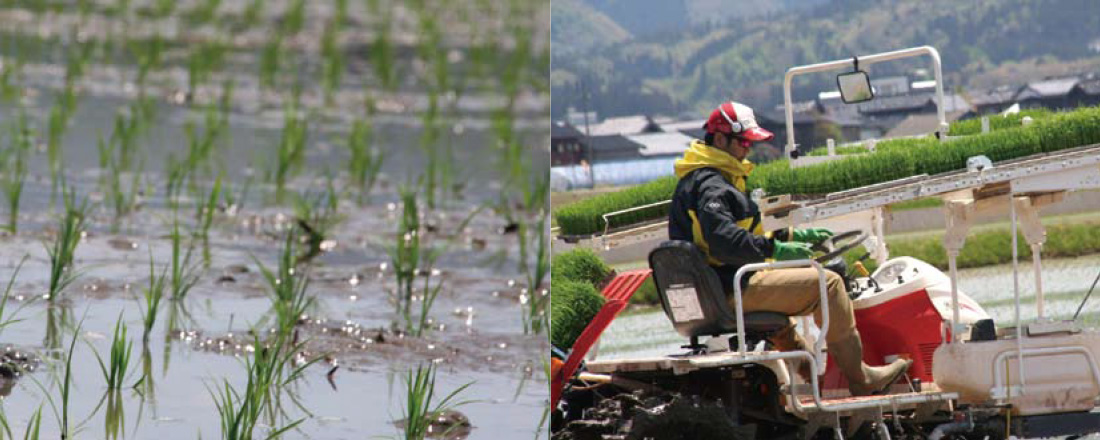
夏の作業
Summer of work水の管理Water administration
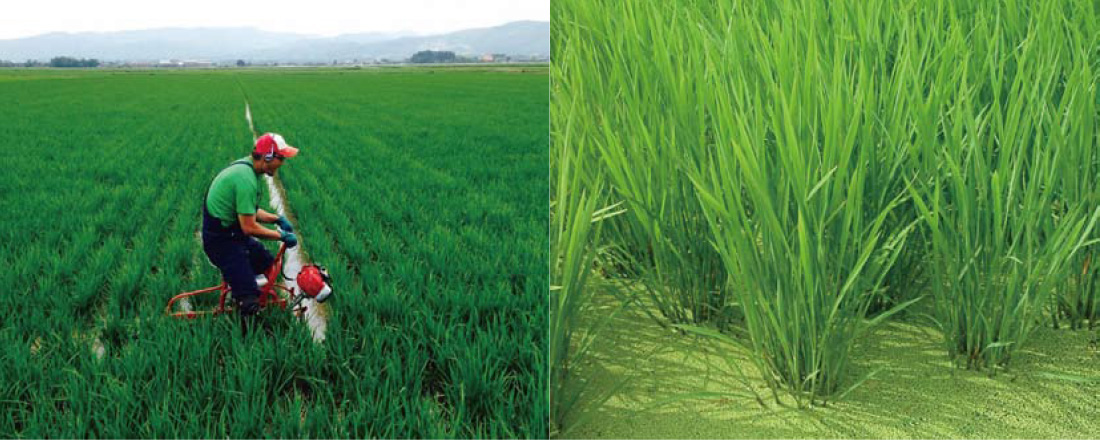
田植え後、苗が根づいてくると、水の管理を徹底します。この時期から朝・昼・晩と田んぼの見回りが始まります。ここで大切なのは、「溝きり」と「中干し」の作業をきちんとやることです。「溝きり」は稲の間に小さな溝を作ることによって、水の走りをよくするものです。これをやることによって田んぼにムラなく水を供給することができます。「中干し」とは田んぼに張った水を、一度抜いて乾かし、土にヒビを作ることによって酸素を与えます。これによって根腐りを防ぎ、根を丈夫にします。苗に与える水はカルシウムやミネラル分を多く含んだ佐渡産の牡蠣殻をドラム缶に入れた「カキ殻用水改良装置」を通して与えます。
A fter the seedlings take roots, we controll water supply thoroughly. In this period, we patrol around therice fields and check the water three times a day; morning, midday, and evening. The most important processes are irrigation and drying: during the irrigation process, we dig thin ditches so that water can be evenly spread thoughout the fields: and in the drying process, all the water inside the fields are drained and well-dried so that oxygen can enter into the soil though the cracks. Drying also prevents the roots from rotting and makes roots stronger. Additionally, it makes the soil solid and later prevents rice reaping machine from sinking into the mud during the harvesting process. Then we supply water again through Oyster Shell Water Improvement Apparatus which are metal drums filled with oyster shells of Sado.
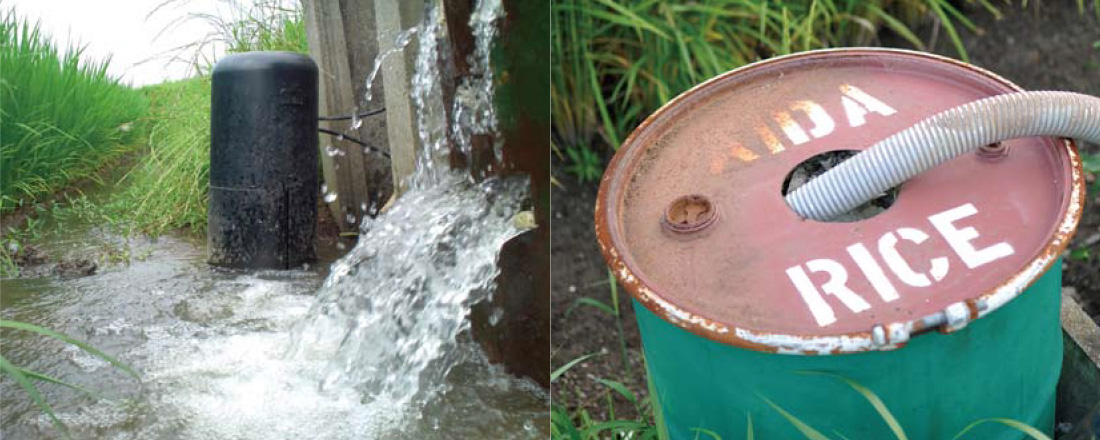
穂肥(ほごえ)Growing of panicles
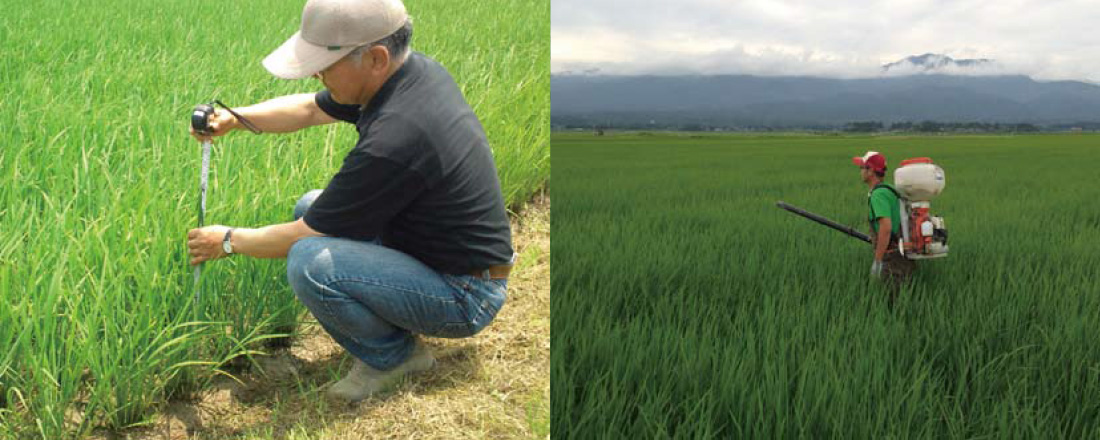
この時期は稲がぐんぐん伸びていきます。“ お腹をすかせた成長期の子ども” のようです。そのため春に撒いた肥料がなくなり、肥料を追加します。そのタイミングは、稲が穂を出す20日前を目安にします。しかし、それぞれの田んぼの立地条件で成長速度は違ってきます。そこで常に稲の高さや草の色を測ったり、茎に切り込みを入れて幼穂の長さを測り、日々の成長速度、前後1週間の天候と積算気温等を加味し肥料を与えます。肥料は、有機肥料(魚エキスペレット等)を中心に与え、3大栄養素のチッソ、リン、カリを補充します。稲の生育状況を見極め、小まめに肥料を与えます。「穂肥」の時期、約1ヶ月は常にさまざまな種類の肥料をトラックに載せ、あっちの田んぼ、こっちの田んぼと行ったり来たりしています。
In Summer, the rice plants grow rapidly as if hungry children in growth period. All the nutrition supplied in Spring is consumed, therefore further fertilizer is required. It should be about twenty days before the plants grow panicles, however, the timing depends on the condition of each field. Therefore, it is judged according to the height and color of the rice plants, the length of young panicles, daily growth, and weather and accumulated temparature of seven days before and after the addition of supplementary fertilizer. The fertilizer mainly composed of organic materials such as fish extract, supplemented with three essential nutrients (nitrogen, phosphorous, and potassium). The fertilizer is frequently added as the plants grow. In this growth season of panicles, our trucks moves to between the fields.
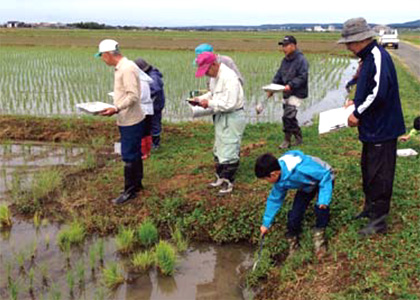
生き物調査Biosurvey
佐渡市は全島をあげて「生物多様性の島づくり」を進めています。その取り組みの一環として田んぼの生き物調査を、毎年6月と8月に実施しています。実際に私たちの田んぼでも調査が行われますが、普段では気づかないほど多くの生き物がいて驚かされます。調査は子どもたちと一緒に行います。40種類以上の生き物を見つけることができす。朱鷺をはじめとした鳥類、カエル、ドジョウ、ホタル、トンボ、クモ類、昆虫など、この土地の豊かさを実感します。また、これによって、害虫の発生源を特定し、効果的な予防・対策を実施して、農薬の使用を抑えることができたらと考えています。
The whole Sado Island promotes the campaign to maintain “Biodiverse Island”. Thus, a biosurvey in rice fields is conducted twice a year, in June and August. Our rice fields are also surveyed. It is surprising to find so many organisms live in a rice field. Sometimes we let children join in a survey team. At a survey, we have found more than 40 species, such as, birds such as Toki, frogs, loaches, fireflies, dragonflies, spiders, and other insects. It indicates rich biodiversity of the island. The result of the survey will be used to detect the source of pests and to make countermeasures against them, leading to reduce the usage of agrochemicals.
秋の作業
Fall of work稲刈りHarvesting
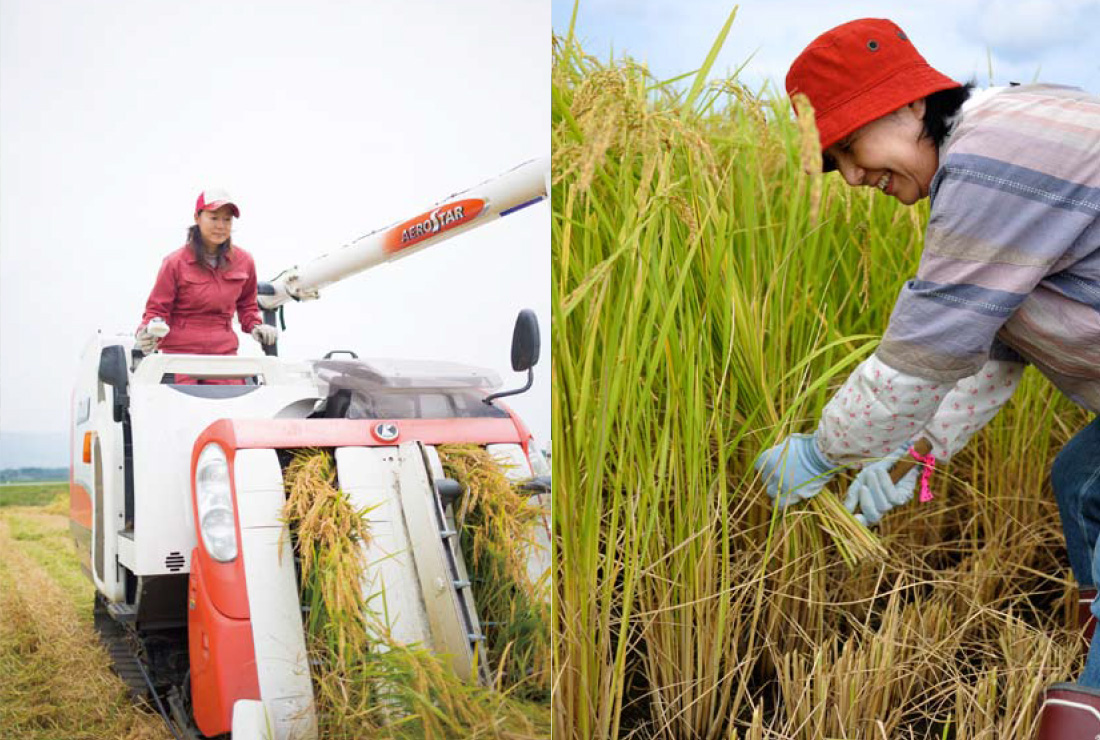
稲刈り前に仕上げの「灌水(水やり)」を行います。6月に「溝きり」「中干し」をしっかりと行うと、水の走りもよく、稲全体に最後の水分を与えることもできます。また、水はけも良く田んぼが乾きやすい為、稲刈り作業もしやすくなります。稲刈りは籾の黄化状況をみて、刈り取り適期を見極めます。稲刈りもまた家族総出でにぎやかになります。
刈取り直後の籾殻の付いたお米は含水率が25~6%あります。それを遠赤外線乾燥機で天日干しと同じような状態にし15%までじっくり乾燥させます。その後、1.粗選機、2.籾摺機、3.網目1.80mm ライスグレーダー、4.色彩選別機、5.網目1.85mm ライスグレーダーを使用し籾摺りと選別を行います。業界最高レベルのフルカラーCCDカメラ色彩選別機の導入により、常に安定した高品質玄米を選別します。
Before harvesting, watering is needed one more time. The irrigation and drying done in June make water spreading smoother and draining quicker. The best timing of harvesting is decided according to the color of husks. Again we conduct harvestong with the whole family.
Water content of rice in husk is about 25-26% soon after harvesting. We reduce the percentage to 15% or under with far-infrared ray grain dryer which can give same effect as sun-drying. Afterwards, grains and hulls are seperated using the following instruments; 1. rougher, 2. rice-huller, 3. rice grader with 1.80mm cylinder, 4. color sorting machine, and 5. rice grader with 1.85mm cylinder. To maintain the quality of brawn rice, we use a sorter with the most advanced full-colored CCD.
土づくりAdministration of soil condition
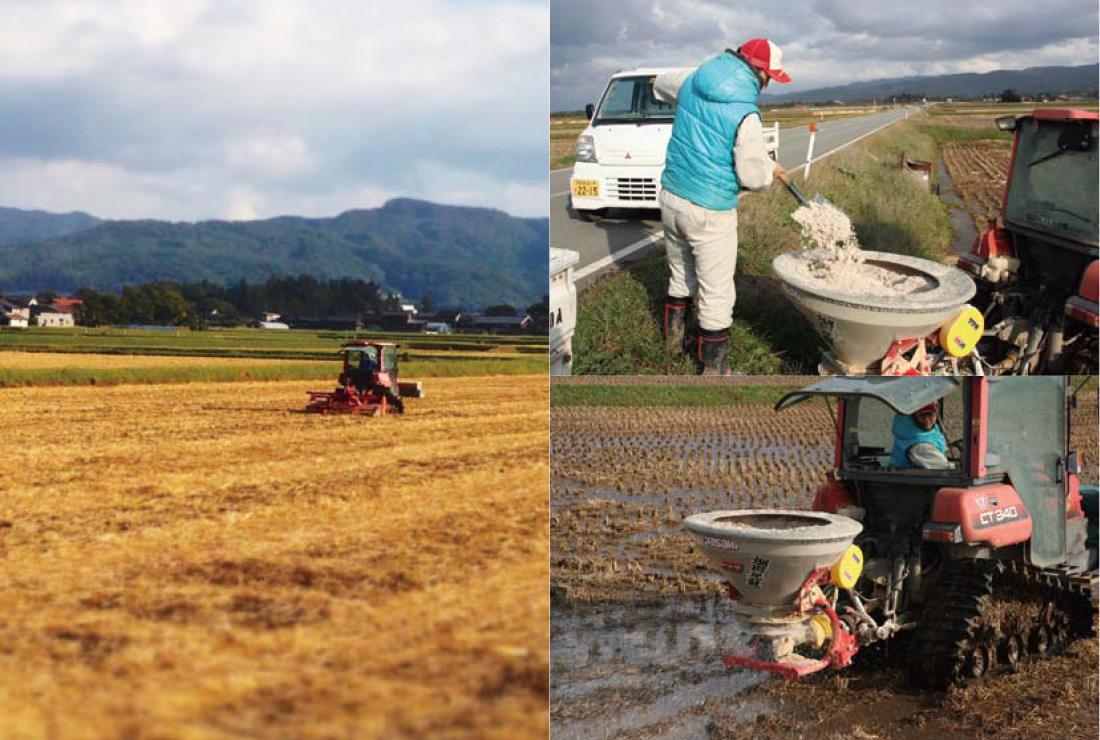
稲刈りが終わった瞬間から、田んぼでは来年の米作りがスタートします。稲刈り作業と平行し、すぐに田んぼの土づくりを始めます。刈り取りの終わった稲わらや根も大切な有機肥料。まだ比較的気温の高いうちに田んぼを耕す「すき込み」を行うことによって、腐蝕が早く進み堆肥化を促します。土の中で生きている微生物の力を有効に使います。また「すき込み」とあわせて、稲に吸い取られたケイ酸やカリの補充や、独自にブレンドした有機肥料として、カキ殻粉末、米ぬか、鶏ふん、牛ふんを加え土づくりを行います。田んぼ全体が大きな堆肥場のようになります。
Soon after harvesting finishes, next year’s cultivation starts. Almost at the same time as the harvesting process, we start preparing soil. Rice straws and roots are important organic fertilizers. Plowing-in before the cold season prompts decomposition and as straws and roots become compost quickly with the help of microbes underground.
Along with plowing-in, we add silicic acid and potassium which are consumed by rice plants and original blend organic fertilizer composed of oyster shell powder, rice bran, poultry manure, and cattle manure. In this period, the whole rice fields look like huge composters.
冬の作業
Winter work出荷Shipping
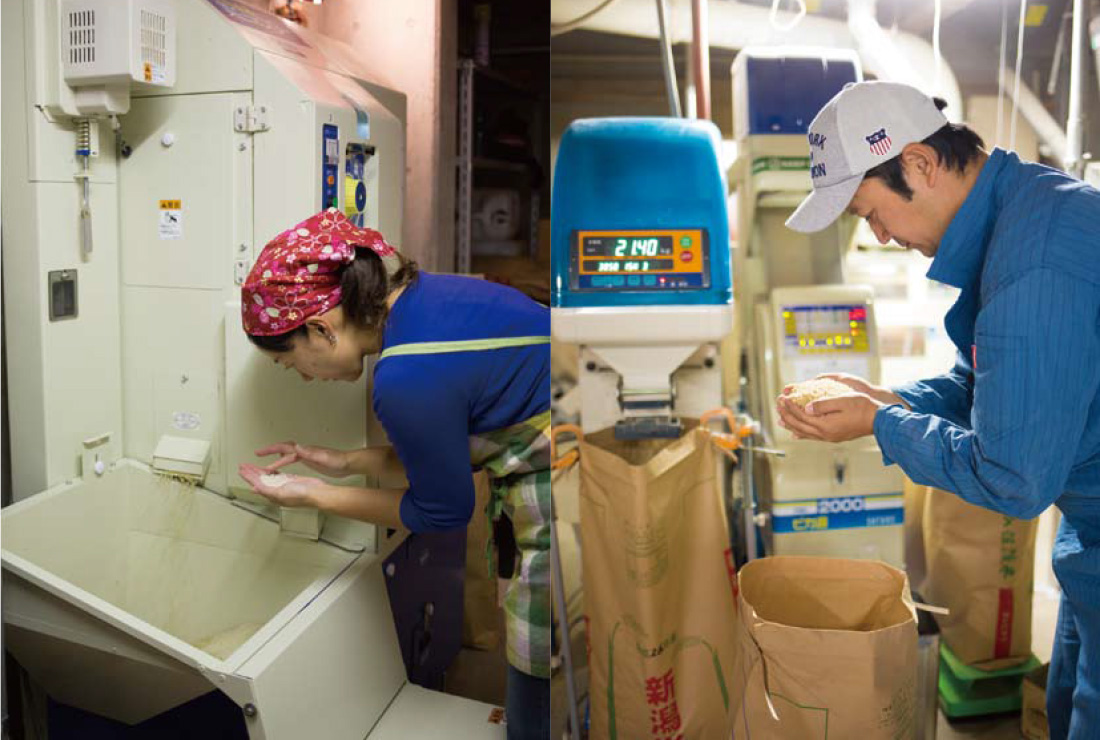
「相田家産佐渡スーパーコシヒカリ」は全量一等米です。「新潟県特別栽培農産物認証米」と「佐渡市朱鷺と暮らす郷づくり認証米」を取得しています。お米の選別は、業界最高レベルのサタケ社色彩選別機「ピカ選」を使用。玄米でもそのまま食べられる品質を安定して確保しています。精米は無洗米まで対応できる専用精米機で注文を受けてから精米を行います。精米後は、3時間程度お米の熱を冷まし、手作業で袋詰めをします。玄米の貯蔵は収穫し検査後、すぐに15度の大型低温冷蔵庫で大切に保管します。
Aida’s Sado Super Koshihikari is 100% 1st grade rice certified as both a Niigata Prefecture Specially Cultivated Agricultural Product and a Rural lnitiative to Promote the Conservation of Toki. For sorting, we use a Pikasen, SATAKE's latest and most advanced selector. The machine enables us to keep certain quality of our brown rice which is as fresh as edible even raw. We polish rice only after we receive orders, and use an exclusive polisher with a function to prepare wash-free rice. Polished rice is cooled down, then packed by hand. Brown rice is kept inside a refridgerated storage 15 degrees soon after undergoing an examination after harvesting.
営業・次年度計画Advertising and planning for next year
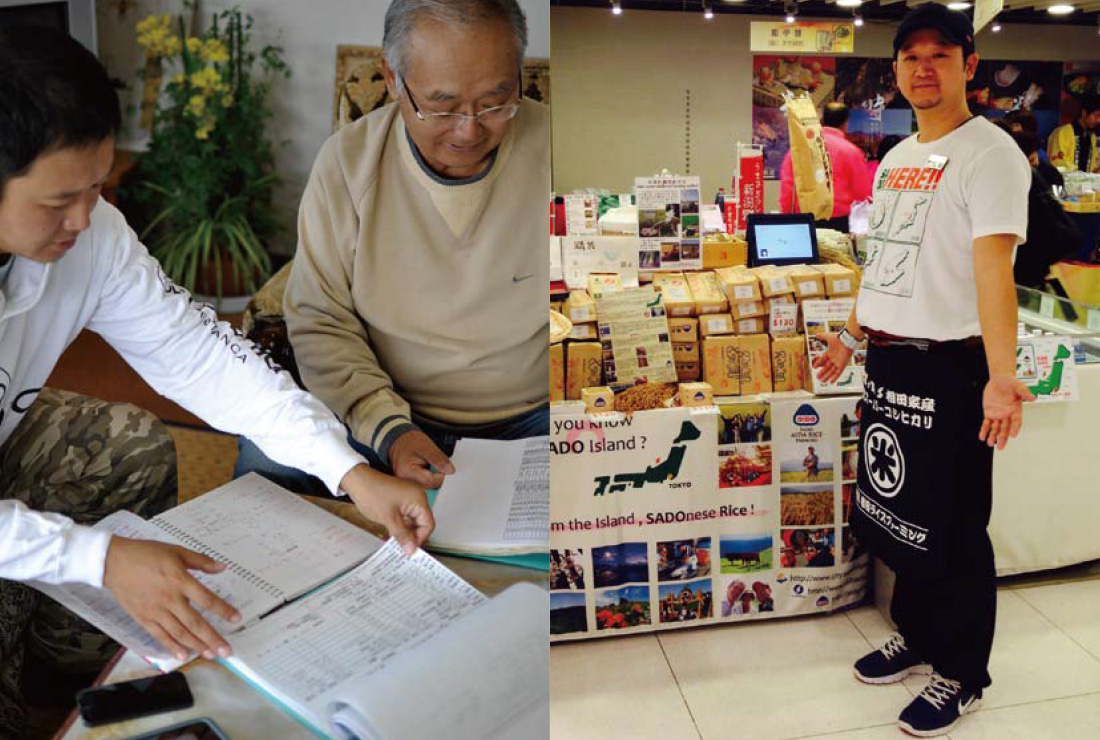
冬の間は国内外への営業活動と次年度の稲作計画を立てます。秋の収穫が終わると関東圏の物産展や商談会へ。2013年からはシンガポールや香港へも出展参加しています。12月中旬からは月1回ペースで打ち合わせを繰り返し、次年度の稲作計画を立てていきます。新しい技術の発見を目的に、大学機関、各専門家、新潟県農業普及指導センターや佐渡市、JA佐渡等の指導もあおぎながら、よりよい米づくりを目指します。冬の間は、次年度へステップアップする大切な時間となります。
During winter, we conduct business activities and plan next year’s cultivation scheme. After harvesting, we participate in food exhibitions and business meetings in Kanto region. We also exhibit our products in Singapore and Hongkong each year since 2013. From the middle of December onward, we arrange meetings every month to create a scheme of next year’s cultivation with the instructions of universities, specialists, JA Sado, Niigata Agricultural Promotion and Instruction Center, etc. Winter is imortant period for us to improve the condition for next year.
世界農業遺産の島「佐渡ヶ島」で
稲職人「相田家」が妥協なしに育てたお米、是非ご賞味ください!
